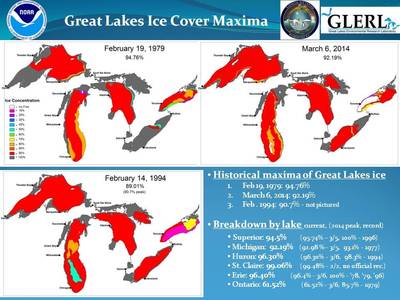Ice Blockade Halves March Lakes Shipping
Ice formations, the likes of which have not been seen in decades, severely limited cargo movement in U.S.-flag vessels on the Great Lakes in March. Shipments of iron ore, coal and cement in “lakers” totaled 980,000 tons, a decrease of 55 percent compared to a year ago. Some of the cargo that was loaded in March was not delivered until April 7 or later.
Iron ore cargos totaled 827,000 tons, a decrease of 47 percent compared to a year ago. Most of the ore was loaded at Escanaba, Michigan, or shuttled within Cleveland Harbor. Only 67,000 tons were loaded at a Lake Superior port, and the ice formations on Lake Superior and the St. Marys River were so thick that that those cargos were not delivered until April 7 or later. Under normal circumstances those cargos should have been delivered in late March or early April.
Resumption of the coal trade was likewise slowed by winter’s grip on the Lakes. Shipments totaled 103,000 tons, a decrease of 44.5 percent compared to a year ago.
The only other dry-bulk cargo to move in March was cement and shipments fell to 52,000 tons, a decrease of 67 percent compared to a year ago.
Through March 31, U.S.-flag cargos total 3.2 million tons, a decrease of nearly 39 percent compared to the same point in 2013.
The extreme ice conditions will have an impact on cargo movement in April was well. As of April 1, only 23 U.S.-flag lakers were in service. A year earlier 38 vessels were in operation. Forty U.S.-flag lakers were moving on April 1, 2012.
lcaships.com













